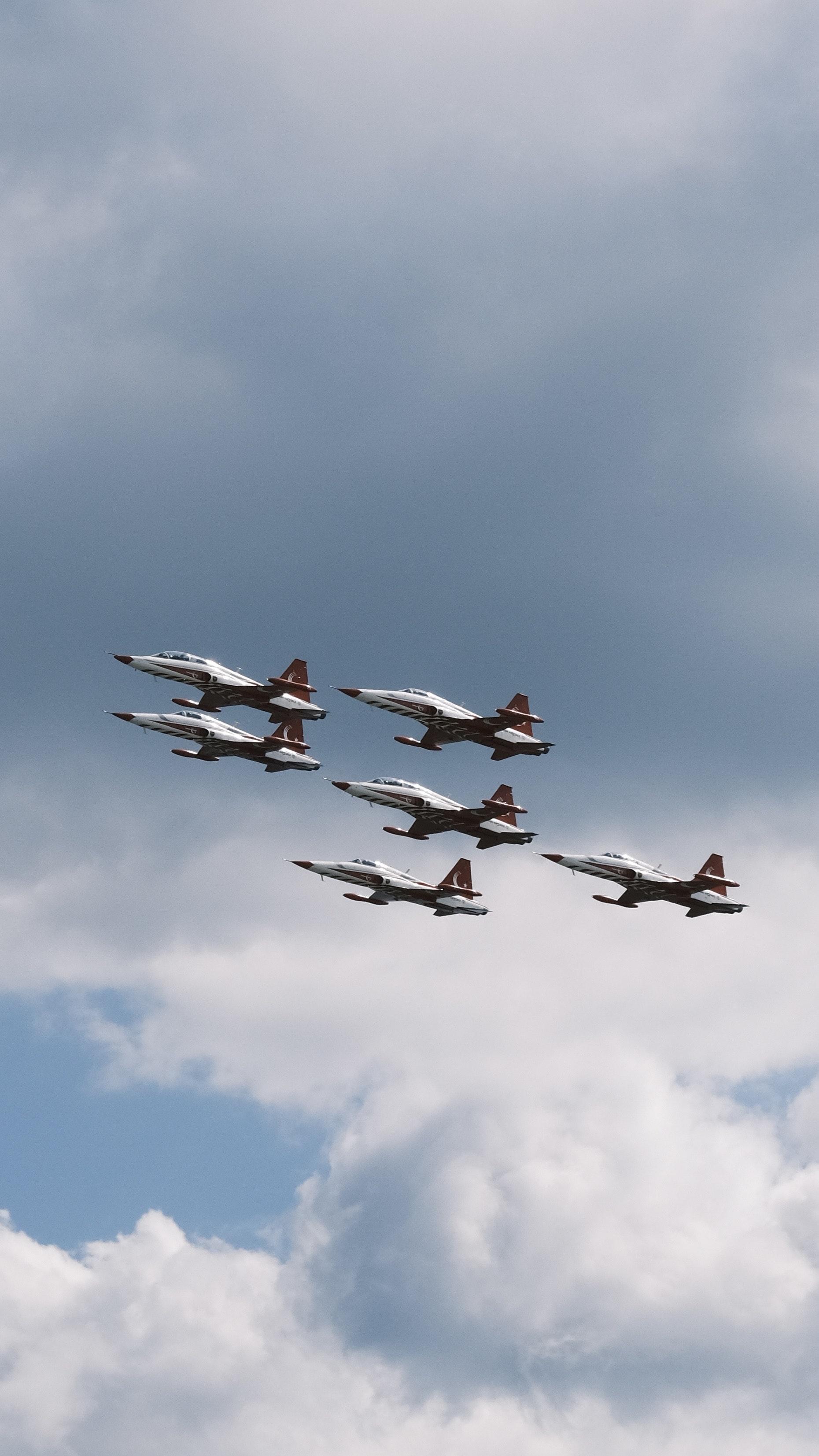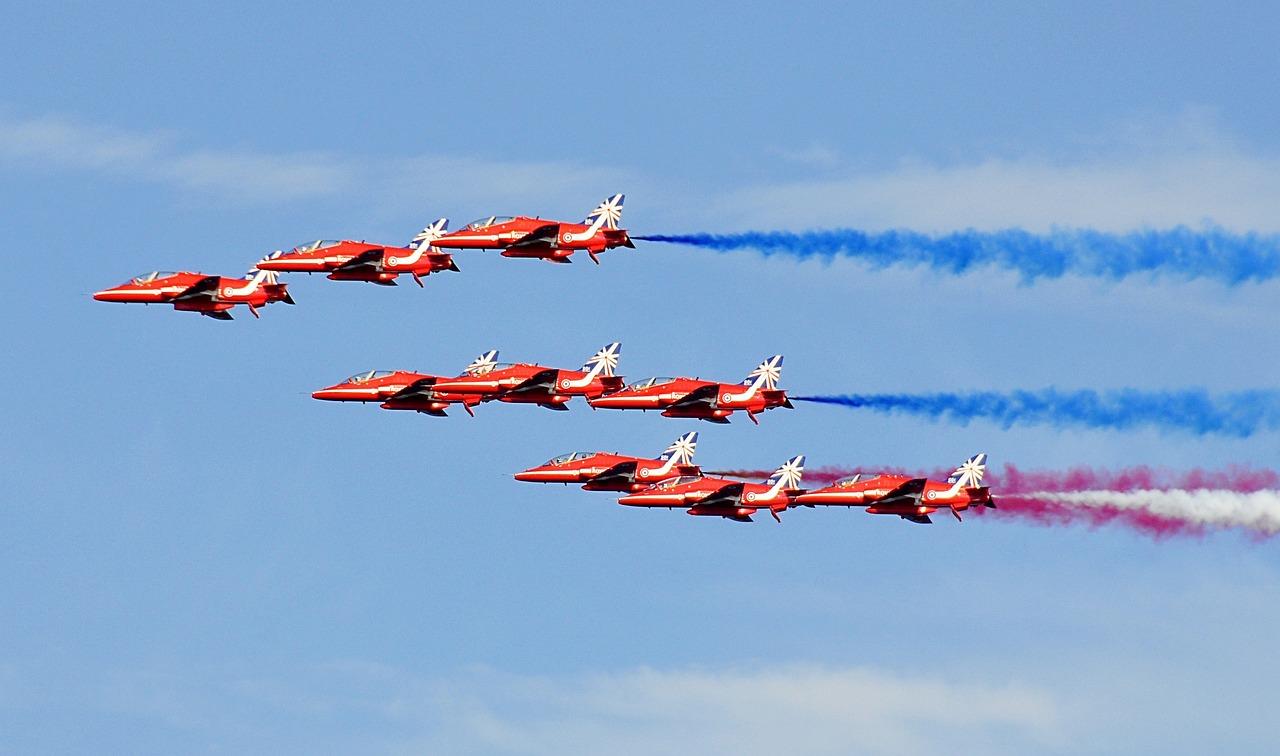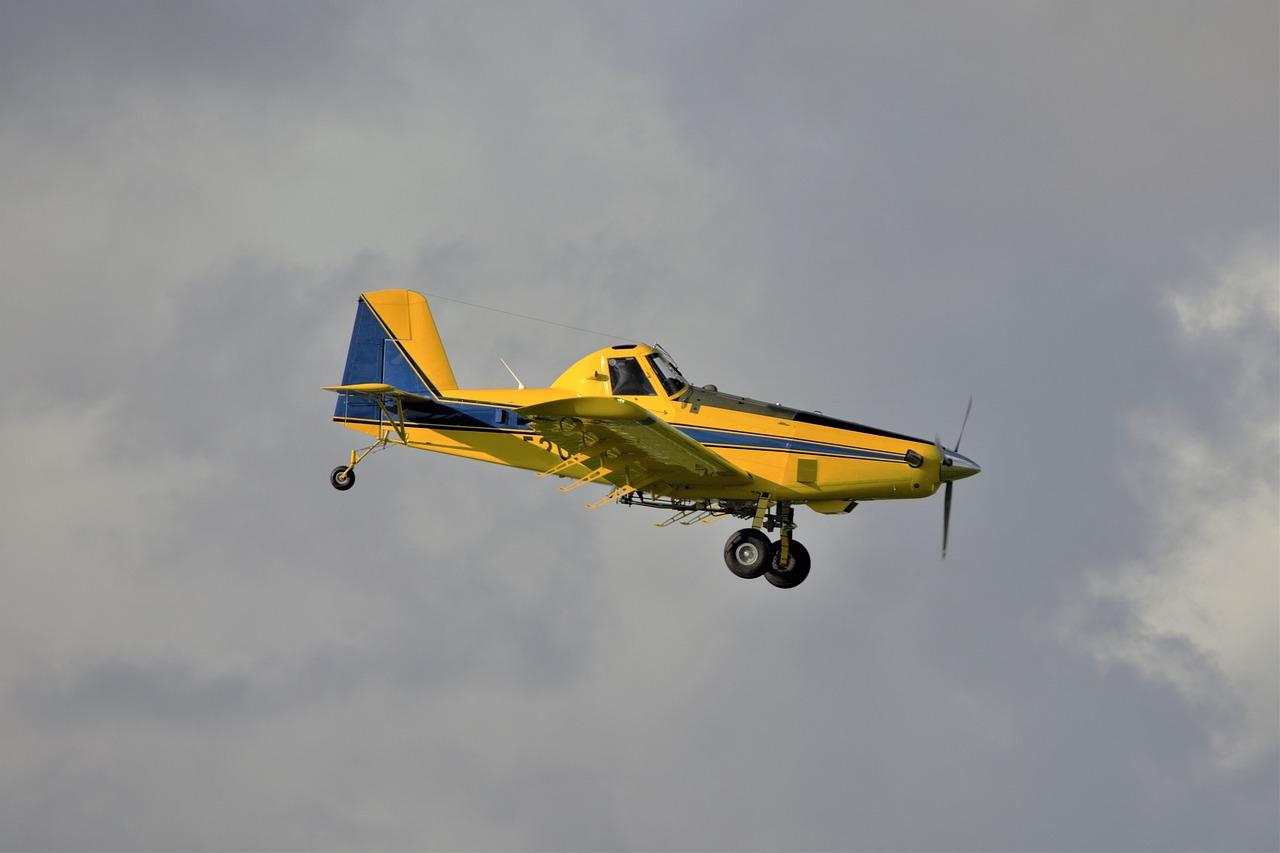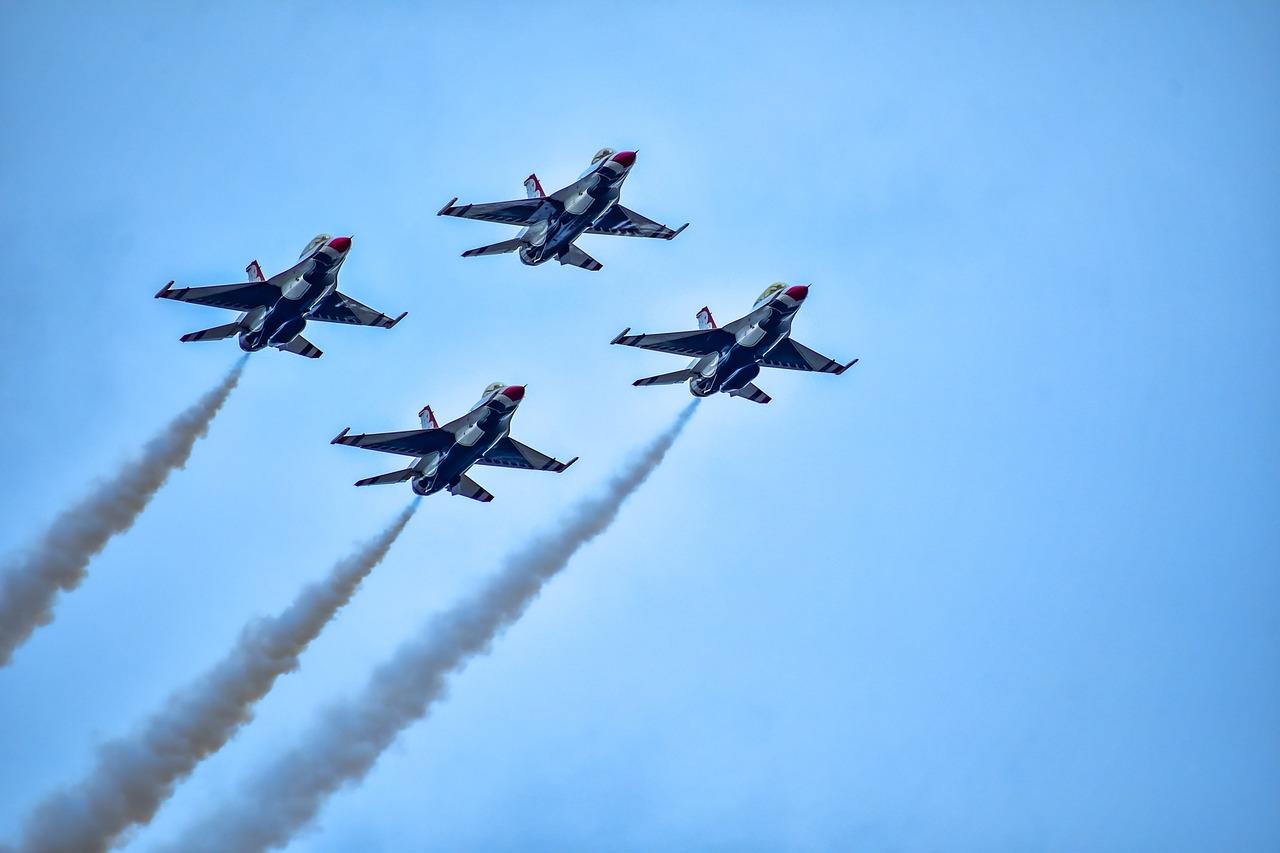If you’re a fan of impressive aerial displays and the thrill of high-speed maneuvers, then you’ve probably heard of the Blue Angels, Thunderbirds, and Snowbirds. These renowned demonstration teams take to the skies to showcase the remarkable capabilities of their aircraft and the skill of their pilots. But what sets them apart? In this blog post, we’ll dive into the world of these elite flying squads and explore their unique characteristics, aircraft, and jaw-dropping performances. So fasten your seatbelts and get ready for an exhilarating journey through the blue skies!
Blue Angels vs Thunderbirds vs Snowbirds
Introduction
Welcome to our ultimate showdown between three of the most renowned aerobatic teams: the Blue Angels, the Thunderbirds, and the Snowbirds. Get ready for a friendly, albeit intense, battle in the skies as these teams showcase their skill, precision, and jaw-dropping maneuvers. So sit tight, buckle up, and let the competition begin!
Team Origins
Blue Angels: Born to Fly in Blue
The Blue Angels, known for their distinctive navy blue aircraft, were formed in 1946. This illustrious team comprises the best of the United States Navy and Marine Corps pilots who possess nerves of steel and a flair for the dramatic. Their aerobatic displays have been thrilling audiences for decades.
Thunderbirds: Roaring Through the Skies
Hailing from the United States Air Force, the Thunderbirds were established in 1953. Their aircraft boast a striking red, white, and blue color scheme, which perfectly complements their high-octane performances. These skilled pilots push the boundaries of physics while leaving spectators in awe.
Snowbirds: Flying with a Canadian Flair
The Snowbirds, the pride of Canada, took flight in 1971. Dressed in radiant white and red, their aircraft dance across the sky with elegance and style. As a demonstration team of the Royal Canadian Air Force, they captivate audiences with their dazzling formations and breathtaking maneuvers.
Key Distinctions
Aircraft Types
The Blue Angels employ a fleet of F/A-18 Hornets, a formidable fighter jet known for its speed and agility. Meanwhile, the Thunderbirds soar through the clouds in F-16 Fighting Falcons, sleek and dynamic aircraft capable of mind-boggling aerial acrobatics. On the other hand, the Snowbirds gracefully navigate the sky with their CT-114 Tutor jets, symbolizing the harmony between precision and grace.
Signature Maneuvers
The Blue Angels are famous for their iconic Diamond Formation, where four aircraft fly in close proximity with flawless synchronization. The Thunderbirds, on the other hand, astound audiences with their signature Delta Formation, showcasing the immense power and agility of their pilots. Lastly, the Snowbirds wow onlookers with their thrilling Heart Formation, symbolizing unity, precision, and the radiance of their performances.
Though each team brings its unique style and pizzazz to the skies, one thing is certain: the Blue Angels, the Thunderbirds, and the Snowbirds never fail to amaze and inspire. So, whether you’re a die-hard aviation enthusiast or simply someone in search of an unforgettable experience, these aerobatic teams are guaranteed to leave you breathless. Strap in, enjoy the ride, and witness the magic unfold in the ultimate showdown of skill and artistry!
What Planes Do the Snowbirds Fly
The Snowbirds are a Canadian aerobatics team known for their jaw-dropping aerial displays. But have you ever wondered what kind of planes these daring pilots soar through the skies in? Let’s take a closer look at the magnificent aircraft that make up the Snowbirds fleet!
The CT-114 Tutor: The Backbone of the Snowbirds
At the heart of the Snowbirds team is the trusty CT-114 Tutor. This sleek and nimble aircraft is the perfect companion for high-flying stunts and acrobatics. Originally designed as a training jet for the Royal Canadian Air Force, the Tutor found its true calling as the backbone of the Snowbirds fleet.
Powered by a Rolls-Royce Engine
Under the Tutor’s hood lies the power of a Rolls-Royce Viper Mk 11 engine. With its ability to generate an impressive amount of thrust, this engine allows the Snowbirds to perform their gravity-defying tricks with precision and grace. It’s safe to say that this powerful partnership between plane and engine is what makes the Snowbirds soar above the rest.
A Striking Red and White Paint Scheme
As the Snowbirds streak across the sky, their planes leave an eye-catching trail of red and white in their wake. Sporting a bold and distinctive paint scheme, these aircraft are a visual representation of Canadian pride. The vibrant colors not only make the Snowbirds easily recognizable during their performances but also add a touch of flair to the skies.
The Teamwork of Nine Tutors
When the Snowbirds take to the air, it’s not just one plane stealing the show—it’s a meticulously choreographed display of teamwork. The Snowbirds squadron consists of nine CT-114 Tutors, each operated by a highly skilled pilot. Together, they execute breathtaking maneuvers and intricate formations that leave spectators in awe.
Maintained by a Dedicated Ground Crew
Behind every successful Snowbirds performance is a team of dedicated individuals on the ground. The skilled mechanics and technicians of the Snowbirds’ ground crew ensure that each plane is in pristine condition, ready to take flight at a moment’s notice. From regular maintenance to intricate repairs, their expertise keeps the fleet flying high.
The Snowbirds take to the skies in their trusty CT-114 Tutors, powered by Rolls-Royce engines. Their striking red and white paint scheme adds a dash of Canadian pride to their performances. With a fleet of nine aircraft and a dedicated ground crew, the Snowbirds create mesmerizing aerial displays that captivate audiences across the world. Next time you see these amazing pilots in action, you’ll have a deeper appreciation for the incredible planes they fly.
Blue Angels vs Thunderbirds vs Red Arrows
When it comes to aerial acrobatics and jaw-dropping stunts, the Blue Angels, Thunderbirds, and Red Arrows are three of the most elite aviation teams in the world. These high-flying squads have captured the imaginations of spectators worldwide with their mesmerizing performances. But how do they compare to each other? Let’s take a closer look at the Blue Angels vs Thunderbirds vs Red Arrows showdown.
Formation Flying Frenzy
The Blue Angels are renowned for their precision and synchronicity in the air. Their diamond formation, with six jet aircraft flying in perfect harmony, is a breathtaking sight to behold. The team’s dedication to accuracy is unrivaled, making their maneuvers a treat for the eyes.
The Thunderbirds bring their own flair to formation flying. Known for their dynamic and daring maneuvers, they push the boundaries of what is possible in the sky. From their close passes to their signature solo “High Bomb Burst,” the Thunderbirds deliver a heart-pumping performance.
The Red Arrows, representing the United Kingdom, are legendary for their awe-inspiring formations. With nine aircraft creating intricate shapes and trails of red, white, and blue smoke, they leave spectators in awe. The Red Arrows’ graceful maneuvers and tight formations demonstrate the immense skill of their pilots.
Thrilling Stunts and Daring Maneuvers
While formation flying is impressive, these teams are not afraid to show off their individual skills with thrilling stunts and daring maneuvers.
The Blue Angels wow the crowd with their famous “Sneak Pass,” where one jet zooms low and fast over the heads of spectators, leaving them breathless. Their tightly executed loops, rolls, and inverted flying showcase their exceptional piloting expertise.
The Thunderbirds are known for their jaw-dropping head-on passes, daring loops, and thrilling barrel rolls that will make your stomach drop. Their synchronized maneuvers, like the iconic “Opposing Knife-Edge Pass,” leave the audience in a state of exhilaration.
The Red Arrows are masters of precision and elegance, showcasing their skill in maneuvers such as the famous “Corkscrew.” Their high-speed passes and astonishing dynamic loops demonstrate the pilots’ exceptional control and coordination.
So, Who Reigns Supreme
In this epic clash of aviation virtuosos, each team has its unique strengths and captivating performances. The Blue Angels impress with their precision formation flying, the Thunderbirds with their daring and dynamic stunts, and the Red Arrows with their graceful elegance.
But determining a clear winner is like comparing apples to oranges (or jets to planes, in this case). Each team brings its own distinctive style and charm to the skies, ensuring an unforgettable show for spectators worldwide. So, whether you’re a fan of precision, thrill, or elegance, there’s an aviation team that will leave you in awe.
Are the Thunderbirds Better than the Blue Angels
When it comes to epic aviation shows, it’s hard not to be wowed by the incredible skills and daring aerobatics of both the Thunderbirds and the Blue Angels. These teams have been captivating audiences for decades with their jaw-dropping performances. But the question remains: who is better? Let’s dive into the friendly rivalry between these two iconic teams and settle the score once and for all.
Thunderbirds: Thunder and Lightning!
The Thunderbirds, also known as the United States Air Force Air Demonstration Squadron, have been stunning crowds since their inception in 1953. These talented pilots are known for their precision maneuvers and their ability to create awe-inspiring formations in the sky. With their signature red, white, and blue F-16 Fighting Falcons streaking through the atmosphere, the Thunderbirds never fail to deliver a heart-pounding performance.
Blue Angels: True Blue Aviators!
On the other side of the aerial battlefield, we have the Blue Angels, the United States Navy’s flight demonstration squadron. Since their establishment in 1946, these daring aviators have been thrilling audiences with their gravity-defying stunts and incredible formations. With their sleek blue and gold F/A-18 Hornets slicing through the air, the Blue Angels bring their unique flair and style to every performance.
The Clash of the Titans
Both the Thunderbirds and the Blue Angels are undoubtedly top-notch in their own right, but what sets them apart? Let’s dig deep into the rivalry and uncover the subtle differences that make each team shine.
Thunderbirds: The Masters of Speed and Precision
The Thunderbirds are all about speed, finesse, and flawless execution. Their aerial displays are a perfect blend of precision maneuvers, jaw-dropping formations, and heart-stopping speed. From their iconic diamond formation to their exhilarating solo displays, the Thunderbirds are a force to be reckoned with in the skies.
Blue Angels: Beauty in Motion
While the Thunderbirds excel in precision, the Blue Angels bring an undeniable charm to their performances. Known for their graceful flight formations and synchronized maneuvers, the Blue Angels seem to effortlessly dance through the sky. Their attention to detail and the elegant beauty of their displays make them a favorite among aviation enthusiasts worldwide.
The Verdict: A Matter of Taste
In the end, determining which team is better ultimately boils down to personal preference. If you’re someone who appreciates speed, precision, and adrenaline-pumping maneuvers, the Thunderbirds might steal your heart. However, if you find beauty in synchronized harmony, graceful formations, and an enchanting display, the Blue Angels will undoubtedly be your cup of tea.
So, the next time you witness the Thunderbirds or the Blue Angels painting the sky with their mesmerizing performances, take a moment to simply enjoy the show. After all, whether you’re #TeamThunderbirds or #TeamBlueAngels, there’s one thing we can all agree on: these incredible aviators are true sky-bound artists, leaving us in awe and reminding us of the limitless possibilities that exist above us.
Blue Angels and Thunderbirds Flying Together in 2023
The Ultimate Showdown: Blue Angels vs. Thunderbirds
Get ready for an epic battle in the skies! In 2023, the world will witness an extraordinary event as the famous Blue Angels and Thunderbirds join forces for a once-in-a-lifetime performance. Brace yourselves for breathtaking maneuvers, pulse-pounding excitement, and a display of aviation prowess that will leave you speechless.
Aerial Tango: When the Best Meet the Best
It’s like watching two rival dance partners come together to perform the perfect tango. The Blue Angels, known for their precision and graceful formations, will blend their expertise with the Thunderbirds’ awe-inspiring aerobatics. The result? A mesmerizing symphony of speed, skill, and pure adrenaline that will keep you on the edge of your seat.
The Ultimate Rivalry: Who Will Steal the Show
When it comes to aerial supremacy, the rivalry between the Blue Angels and Thunderbirds is legendary. Each team will strive to outdo the other, pushing the limits of their aircraft and capabilities. Prepare for heart-stopping moments as they execute jaw-dropping stunts, daring dives, and mind-boggling maneuvers that seem to defy the laws of physics. Who will steal the show? Only time will tell, but one thing is certain: it will be a battle for the ages.
Behind the Scenes: Training for the Unforgettable
Behind the scenes, these elite pilots train rigorously to ensure flawless performances. They face extreme G-forces, endure intense physical conditioning, and practice endlessly to perfect their routines. Every move, every twist, and every turn is carefully choreographed to create an unforgettable spectacle that will leave spectators in awe.
An Unforgettable Experience for All
Whether you’re an aviation enthusiast, a thrill-seeker, or simply curious about the marvels of flight, witnessing the Blue Angels and Thunderbirds flying together in 2023 promises to be an unforgettable experience. The sheer power, grace, and skill of these pilots will give you a renewed appreciation for the art of flying. So mark your calendar, gather your loved ones, and prepare to be amazed as the sky becomes a canvas for a performance you’ll talk about for years to come.
In the world of aviation, few events can match the excitement and anticipation of the Blue Angels and Thunderbirds joining forces. With their combined talent, dedication, and showmanship, they are set to deliver a mind-blowing spectacle that will undoubtedly go down in history. So get ready to witness the clash of the titans, as the Blue Angels and Thunderbirds take to the skies in 2023 and leave audiences spellbound. Don’t miss out on this extraordinary display of aerial artistry – it’s an experience you won’t want to miss!
What Sets Thunderbirds Apart from Blue Angels
Thunderbirds: The Bold Mavericks
If you’re familiar with the United States Air Force, then you know about the Thunderbirds. These daring aviators are renowned for their jaw-dropping aerial maneuvers and their unmistakable F-16 Fighting Falcons. While the Blue Angels may rock the navy blue charm, the Thunderbirds are the daring Mavericks of the skies.
Blue Angels: The Navy’s Sky Warriors
On the other hand, we have the Blue Angels—a squadron of supercharged pilots hailing from the United States Navy. These daredevils take to the skies in their iconic Blue Angel Hornets, painting the sky with the grace and precision of true sky warriors. They’re famous for their synchronized formation flying, leaving spectators in awe.
Flight Systems: Birds of a Different Feather
When it comes to the aircraft flown by these teams, the Thunderbirds and Blue Angels each have their own unique style. The Thunderbirds operate with F-16 Fighting Falcons, while the Blue Angels prefer the F/A-18 Hornet. Both are exceptional aircraft, designed to push the limits of what’s possible in the air.
Colorful Sky Paintings
While both teams excel at thrilling aerial displays, their performances are anything but identical. The Thunderbirds paint the sky with their daring maneuvers, showcasing tight formations and incredible aerial stunts. The Blue Angels, however, bring their own flavor to the table, wowing audiences with their high-speed passes and heart-stopping vertical climbs.
Mission Objectives and Team Spirit
In terms of mission objectives, the Thunderbirds and Blue Angels differ. The Thunderbirds primarily serve as ambassadors for the United States Air Force, showcasing the capabilities of their aircraft and the skill of their pilots. Conversely, the Blue Angels aim to promote the feeling of pride and professionalism within the U.S. Navy.
Crew Dynamics: The Real Heroes Behind the Scenes
Behind the glamour and excitement of their performances, there’s a dedicated group of professionals keeping these teams soaring. The Thunderbirds consist of nearly 130 airmen who handle various roles, such as maintenance, public affairs, and more. The Blue Angels’ team comprises approximately 140 Navy and Marine Corps personnel, each contributing to the seamless execution of their shows.
Final Verdict: And the Winner Is…
While both the Thunderbirds and the Blue Angels are exceptional in their own right, there is no clear winner in the battle for sky supremacy. Each team brings a unique flavor to their performances, leaving spectators captivated and inspired. So, whether it’s the Thunderbirds’ daring mavericks or the Blue Angels’ naval prowess, both are guaranteed to leave you breathless and yearning for more. Strap in for the sky-high experience of a lifetime!
What Makes the Thunderbirds Different from the Blue Angels
History and Background
The Thunderbirds and the Blue Angels are both legendary aerial demonstration teams, but they have different histories and backgrounds. The Thunderbirds are part of the United States Air Force, while the Blue Angels are part of the United States Navy. The Thunderbirds were established in 1953, whereas the Blue Angels have been flying since 1946. So, there’s a slight age difference between the two teams, but that doesn’t mean they can’t get along like good ol’ pals.
Aircraft and Colors
Now, let’s talk about the aircraft. The Thunderbirds fly the F-16 Fighting Falcon, an agile and sleek machine. On the other hand, the Blue Angels fly the iconic F/A-18 Hornet. So essentially, it’s like comparing a Falcon to a Hornet – one is fast and nimble, while the other has a playful sting.
When it comes to colors, the Thunderbirds sport a bold red, white, and blue paint scheme, representing the colors of the American flag. Meanwhile, the Blue Angels have a dazzling blue and gold color combination. They both look like they’re ready to rock the skies, but in their own fashionable ways.
Formation and Maneuvers
While both teams perform impressive aerial maneuvers, their formations and signature moves set them apart. The Thunderbirds are known for their famous six-plane diamond formation, where the aircraft fly close together, wingtip to wingtip. They also execute precise loops, rolls, and, my personal favorite, the sneak pass. Don’t worry; it’s not as sneaky as it sounds!
On the flip side, the Blue Angels perform in a four-plane diamond formation, with a solo aircraft that joins for some jaw-dropping solo demonstrations. One of their standout maneuvers is the tightest formation loop known as the “Diamond Dirty Loop.” It’s so impressive that it probably leaves even the loop-de-loop roller coasters feeling dizzy with jealousy.
Cultural Significance
Last but not least, both teams hold immense cultural significance. The Thunderbirds represent the United States Air Force and showcase the capabilities of American military aviation. On the other hand, the Blue Angels represent the United States Navy and Marine Corps and promote naval aviation to the public. They not only put on a spectacle in the skies but also inspire the next generation of aviators and aerospace enthusiasts.
So, while the Thunderbirds and the Blue Angels have different backgrounds, aircraft, formations, and cultural importance, they share a common goal – to bring excitement, patriotism, and awe to audiences worldwide. And if you ask me, that’s pretty fly.
That wraps up the comparison between the Thunderbirds and the Blue Angels. Now, let’s move on to the next section and find out how the Snowbirds fit into this friendly rivalry in the world of aerial demonstrations. Hold on tight; it’s about to get snow-tastic!



